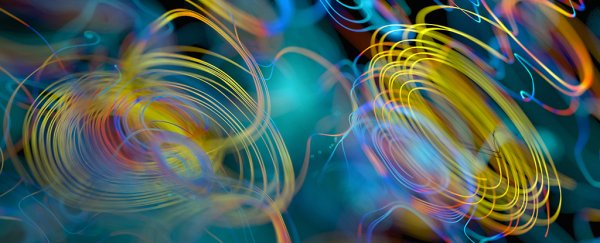For some physicists, measuring the spectrum of tiny waves making up empty space has been a goal for decades, but until now none have found a good way to achieve it.
Now physicists from ETH Zurich have cleverly used laser pulses to understand the quantum nature of a vacuum, setting a landmark in our attempts to measure absolute nothingness.
Our Universe is fundamentally bumpy. Like a fresh canvas yet to be painted, there's a texture to bare reality which we can only just detect.
What we take for the complete absence of matter and radiation is an infinite field of possibility from which particles emerge. In fact, there is a field for every elemental particle, just waiting for sufficient energy to define key features of its existence.
Those particles are all constrained by a strange rule - as some possibilities increase, others have to shrink. A particle can be in a precise location, for example, but it will have a vague momentum. Or vice versa.
This uncertainty principle doesn't just apply to particles. It applies to the vacant field itself.
Standing back, that artist's canvas looks remarkably smooth. Likewise, over an extended period of time, the amount of energy in a volume of empty space averages out to zero.
But as we focus in, for any single moment we become less certain about how much energy we'll find, resulting in a spectrum of probabilities.
We typically think of this weave as random. But there are correlations which could tell us a thing or two about the nature of this rippling.
"The vacuum fluctuations of the electromagnetic field have clearly visible consequences, and among other things, are responsible for the fact that an atom can spontaneously emit light," says physicst Ileana-Cristina Benea-Chelmus from the Institute for Quantum Electronics at ETH Zurich.
To measure most things, you need to establish a starting point. Unfortunately for something already in its lowest energy state, it's a little like measuring the force of a punch from a non-moving fist.
"Traditional detectors for light such as photodiodes are based on the principle that light particles – and hence energy – are absorbed by the detector," says says Benea-Chelmus.
"However, from the vacuum, which represents the lowest energy state of a physical system, no further energy can be extracted."
Rather than measure the transfer of energy from an empty field, the team devised a way to look for the signature of its subtle probability shifts in the polarisation of photons.
By comparing two laser pulses just a trillionth of a second in length, sent through a super-cold crystal at different times and locations, the team could work out how the empty space between the crystal's atoms affected the light.
"Still, the measured signal is absolutely tiny, and we really had to max out our experimental capabilities of measuring very small fields," says physicist Jérôme Faist.
Tiny is an understatement. That quantum 'wiggle' was so small, they needed up to a trillion observations for each comparison just to be sure the measurements were legitimate.
As miniscule as the final results happened to be, the measurements allowed them to determine the fine spectrum of an electromagnetic field in its ground state.
Getting a grip on what is effectively empty space is becoming a big deal in quantum physics.
Only recently, another team of physicists attempted to put limits on the noise of a vacuum at room temperature in order to improve the functionality of the gravitational wave detector LIGO.
Virtual particles – the brief ghosts of possible particles that barely exist as uncertainties in a field – are also key to understanding how black holes slowly evaporate away over time through Hawking radiation.
In the future, we'll need even more tricks like these if we're to understand the fabric the Universe is painted on.
This research was published in Nature.
